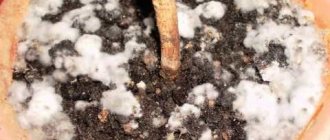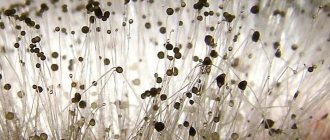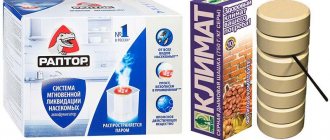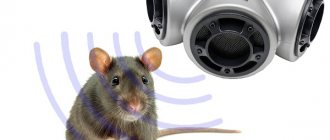What is mold and why is it harmful?
The mold that we see in our homes is a fungus. It develops from a spore.
A spore is a microorganism protected by a durable shell. The mold that develops from it is a multicellular organism formed by long fibrous threads (hyphae). Moreover, it grows from the spore at high speed, “capturing” the surrounding surface.
A mold spore is a microscopic, single-celled capsule with a tough shell.
Nature has made sure that spores can withstand difficult conditions; they are carried with air currents and cling to objects. And for mold to begin to grow from this “capsule”, certain favorable factors are needed, which we ourselves create in our homes:
- Increased air temperature (many people like to warm themselves and turn on heaters).
- Increased humidity (for example, in a bathtub, where clothes are often dried for a long time, puddles remain on the floor after bathing, floor mats are not dried, etc.).
- Lack of access to fresh air (insufficient ventilation of premises).
Mold loves a moist environment and multiplies quickly there
Various types of mold can grow on almost any surface: concrete, wood, paper, fabric, food. The fungus especially likes to settle next to plastic windows, because condensation sometimes accumulates there. Over time, mold can destroy the walls, ceiling, and floor of a room.
How to get rid of mold in the bathroom?
The bathroom is one of the suitable places for the localization of mold fungi. Black spots of varying sizes can often be seen in corners, on ceilings and walls. They cannot be ignored. Use the standard algorithm of actions:
- Determine the depth of the growth. When black spots are located on the surface, they can be easily removed mechanically. If mold penetrates under the plaster or facing tiles, get ready for repairs.
- Examine the room for the extent of the damage. Check not only visually noticeable areas - sink, faucet, bathtub. Pay attention to heated towel rails, seams between tiles, and the space under the bathtub.
- Eliminate the causes of mold: leaking taps, poor operation of the hood.
- Clean the affected area mechanically. You can use industrial or folk remedies.
- Carry out antiseptic treatment.
Eliminating fungal colonies is only getting rid of half the problems. It is important to prevent their occurrence in the future. This can be achieved by regularly checking the condition of surfaces. In order not to create an environment favorable for microorganisms, you need to avoid drying clothes in the bathroom and taking water procedures with a lot of steam. Installing a “warm floor” will also help. With it, surfaces will dry faster.
Methods of infection of the body: through food, air in the room and direct contact
Mold can penetrate the human body and cause various problems there in various ways:
- Air route. Mold spores are suspended in the air. They easily enter the human respiratory tract and then “travel” throughout the body. Moreover, spores are powerful allergens.
- Eating moldy foods. Of course, if there is mold in the product, this becomes immediately clear from the characteristic smell. However, some people are in no hurry to throw away such food, but simply remove the spoiled layer from the bread or cut off the green pulp from the fruit. This cannot be done, because the mold fibers go deep inside, although this is not visible from the outside. As a result, a person gets food poisoning, sometimes very severe (intoxication of the body occurs).
- Touching mold. When human skin comes into contact with mold, mycoses (a type of skin disease) can occur, this is especially likely if the immune system is reduced. Not only the upper layers of the epidermis are affected, but also the subcutaneous fat. Fungi can go further, causing diseases of muscles and bones, penetrating into internal organs.
Main habitats of black mold
An environment that negatively affects human health, in which pathogenic microorganisms occupy the main place, can become a source of increased danger in a house or apartment. Getting rid of fungus, the appearance of which in the bathroom or toilet often goes unnoticed for quite a long time, can take years. You also have to deal with it on the walls in residential areas - especially if they are lined with plastic that does not allow air to pass through. Among other places that are primarily attacked by colonies of microorganisms, we can note:
- window frames;
- area under the windowsill;
- sections of walls under baseboards;
- doorways;
- ceiling;
- surface of water pipes;
- internal space of the refrigeration unit;
- air conditioning systems.
This is where mold often goes completely undetected, putting people's lives and health at risk.
Why does she appear?
Why can mold fungi appear in living spaces? First of all, risk factors here are such things as impaired air exchange and high humidity in the premises. Environmental influences may also be important. For example, in many high-rise buildings there are “cold” walls, on which condensation actively forms in the bathroom space in winter. Of course, the reason for the appearance of pathogenic microflora in this case is superimposed on the formation of a favorable environment for the colonization of mold on surfaces.
The presence of the necessary nutrient medium is another important factor contributing to the emergence of a dangerous microorganism. Products of organic and inorganic origin can become food for mold. Particles of dust and dirt, wallpaper paste, stale bread crust - all this can contribute to the growth of the problem. And the further things go, the more difficult it will be to succeed in combating the source of the biological hazard.
Opinion of our clients: I always believed that mold only occurs in damp basements. When small black spots appeared on the plaster in the kitchen and bathroom, I didn’t attach much importance to it. But gradually a specific smell appeared in the house. And I myself was practically suffocating. I turned to specialists, they confirmed that the source of danger was literally under my nose all this time.
Preventive measures: will they help?
There is an opinion that black mold appears only where insufficient measures are taken to maintain cleanliness. Specialists of the Sanepidemstation.com service are ready to dispel this misconception:
It is important to understand that frequent cleaning and maintaining the required level of hygienic cleanliness in the house is just the tip of the iceberg. In order for a mold colony to grow, it is also necessary that there is a violation of air exchange in the living space (due to improper ventilation, lack of ventilation) and a high level of humidity. Even the use of today's fashionable air humidifiers, improper care of the air conditioning system, and poor cleaning of the aquarium are risk factors that are rarely taken into account by home and apartment owners.
Cleaning alone will not be enough as a preventive measure. That is why, having discovered possible signs of fungus on the surfaces of walls, floors, and ceilings, you should immediately take decisive action.
Mold Dangers to Pets and Houseplants
It turns out that mold is harmful not only to people, but also to other living inhabitants of a private house or apartment. We are talking about indoor plants and pets.
Thus, an insidious fungus more often than usual affects flowers that do not require intensive watering, and therefore are not able to absorb a lot of moisture at once (for example, cacti, aloe, violets, “money tree”, etc.) At the same time, mold can attack both soil and and the plant itself (in this case, the leaves begin to rot, turn black, and curl).
Mold can affect both the indoor plant itself and the soil in which it grows.
Of course, mold affects the plant negatively:
- Deteriorates soil quality. It disrupts water and mineral metabolism, acid-base balance.
- Death of the plant. The top layer of soil can turn into a crust that retains moisture and does not allow air to pass through. The roots begin to rot, then the branches and leaves die.
- Mold can “move” onto the windowsill, window frames, walls, and ceiling.
As for pets, if they inhale spores or tactile contact with mold, they may experience breathing problems (including pulmonary edema) and disruptions in the functioning of the nervous system. In case of severe poisoning, death cannot be ruled out.
If spores of certain types of mold enter the body of a weakened animal (for example, an old animal or a pet after an injury), then the fungus can affect internal organs.
Why are mold and mildew dangerous?
Allergy. Mold in an apartment is a very strong allergen that causes various allergic symptoms, such as tearing, skin rashes, etc. In general, doctors notice that people prone to allergies more quickly and acutely feel the appearance of mold in the room.
Why is mold in an apartment dangerous for children ? Children with weakened immune systems are especially susceptible to the influence of fungi. However, often, living in a house affected by mold, even perfectly healthy children begin to get sick. Moreover, doctors often cannot even explain the reasons for these health problems until the parents discover a fungus in the apartment.
If the fungus is in the bathroom (and there is a more favorable environment for its development - warm, humid and damp), its spores land on hygiene items, migrating to the skin, genitals or oral cavity during bathing or brushing teeth. This causes the appearance of genital candidiasis, stomatitis, etc.
If the fungus settles in the kitchen or dining room, where humidity is often high, it gets onto the food and, along with it, into the body. Fungal waste products called mycotoxins are especially dangerous. Their danger is that they accumulate in the body, causing toxic damage to the liver, which can no longer cope with the growing population of fungi. Mold spores can often be found on plates.
Mycotoxicosis manifests itself in three forms - respiratory, food and skin. The most aggressive food form, which is manifested by nausea, vomiting and other dyspeptic disorders.
Remember! If you find a moldy product in your refrigerator, do not cut off the affected area under any circumstances. If mold appears on its surface, then it has already affected the entire product.
Nervous system. Some fungi, once inside the body, immediately begin to have a detrimental effect on the central nervous system. People living in houses with mold experience sleep disturbances, apathy, and depression.
The immune system. Being constantly exposed to fungi, the immune system is under constant stress. “Attacks” of mold reduce it and make it easy prey for other pathogenic microorganisms.
In addition, people with severely weakened immune systems who regularly inhale mold spores can develop aspergillosis. It affects the lungs and, in severe cases, can even cause death.
In this article we looked at the dangers of fungus on walls.
As you can see, fungus in an apartment is very harmful to health and should not be allowed to appear indoors under any circumstances, because prevention is easier than eradication. Mold affects the structure of materials, including construction materials, so when it appears, it is recommended to make repairs. You can also order mold treatment from the sanitary service of your city.
How mold spoils walls and other surfaces in the house, basement and how to get it out
As already mentioned, mold does not spare the building materials of the home. Initially, the fungus concentrates on the surface of plaster, brick, stone, and then penetrates inside, destroying the material from the inside, forming cracks.
If the owners notice mold on the ceiling or walls, it must be eliminated immediately. The stages of such work will be as follows:
- The affected area is cleaned of fungus using a sponge or a metal brush (if there is wallpaper on the wall, you must first tear it off, and similarly remove the layer of plaster).
First of all, you need to clean the affected surface from mold using a sponge or wire brush.
- The surface is treated with an antiseptic (for example, Domestos, Biotsid-S, Abedis 06, Olymp Stop Mold, etc.). It should dry for about 4-5 hours (the exact time depends on the temperature and humidity of the room). If the mold damage was very strong, it is better to repeat the treatment after drying.
- The next step is to coat the wall with a primer (it is better to do this twice after the first layer has dried). This will strengthen the surface and enhance the application of subsequent finishing. By the way, you can buy a primer containing components to combat mold (this will enhance the effect).
- At the end, you need to restore the decorative finishing coating of the ceiling or wall (apply plaster, stick new wallpaper).
As for removing mold from wooden surfaces, the same chemicals indicated are used for this purpose. Many also use folk recipes (table vinegar, hydrogen peroxide, tea tree oil, baking soda).
If the fungus has penetrated deeply into wooden furniture, then it is better to simply get rid of it. After all, under favorable conditions, mold will probably return.
How to eliminate mold in an apartment?
Mold removal must be approached very responsibly. The problem needs to be dealt with comprehensively. First of all, it is necessary to identify the existing causes that contribute to the proliferation of mold fungi.
If the reason is hidden in high humidity, it is necessary to regularly ventilate the apartment, do not dry wet laundry in the house, repair leaking plumbing, etc. If mold appears on the walls, it makes sense to carry out full waterproofing and insulation of the walls.
After eliminating the factors contributing to the growth of mold, they begin directly to remove the fungus. This activity is carried out using special strong disinfectants that are effective against fungal infections. These are the means for disinfecting apartments “Septolite Tetra” and “Septolit DHC”.
All measures to eliminate mold in an apartment must be carried out using personal protective equipment - rubber gloves, a respirator, work clothes.
Fighting mold in the bathroom
The bathroom is a favorite location for mold. And the reason for this is the same high humidity. Mold often appears at the joints between tiles, as well as in the bathtub, shower stall, walls and ceiling.
When trying to eliminate mold in the bathroom, people often notice this pattern: some time after removal, the mold reappears in the same place. This happens because the fungus spreads under the sealant that was applied to the joints.
Therefore, to eliminate mold between joints, you must do the following:
- Using a knife, remove the old silicone sealant.
- Exposed internal seams are carefully cleaned with a knife.
- The internal seams are thoroughly wiped with a rag moistened with a working disinfectant solution. We recommend using “Septolite Tetra” or “Septolite DHC” as a bathroom disinfectant.
- After fifteen minutes, the surface is again treated with a disinfectant.
- After the product has completely dried, the dry surface is filled with silicone sealant.
- Wait a day until the sealant has completely dried.
The problem of mold fungi is also very familiar to owners of shower stalls. Thus, fungus often grows at the joints between cabin panels, in cracks and corners. In this case, first of all, it is necessary to completely disassemble the shower stall, namely: dismantle the doors and walls, remove the tray and set it aside.
Next, the old sealant is completely removed from the joints, the cracks are cleaned and they are treated twice with a disinfectant for shower cabins, for example, the Septolite DHC disinfectant. The surfaces of the removed walls and doors are also wiped with disinfectant. After the surfaces have dried, the cabin is mounted back.
Fighting mold in rooms
The appearance of mold in living rooms poses the greatest threat, because this is where people spend the most time. As a rule, mold fungi affect walls, ceilings, window slopes, and floors. So, if black spots are visible on the wallpaper, this means that there are fungal spores underneath them. It was a pity, but the wallpaper will have to be torn off, after all, health is more important.
Next, bare surfaces (walls, ceiling, floor, internal cracks) are cleaned using spatulas and metal brushes. A disinfectant is applied to cleaned surfaces twice with an interval of fifteen minutes. Where to buy mold disinfectants? These disinfectants can be purchased at the Septolit.ru online store.
After a day, it makes sense to apply a special antiseptic primer to the walls. After the primer has dried, the walls are plastered, primed again and new wallpaper is glued. Another option is to paint the walls with paint designed for wet rooms. This way the walls will always be dry, which means that mold will no longer appear in the apartment.
Return to list of publications
How to treat clothes, books and furniture against fungus
Often, mold also affects clothing, for example, if it has been stored for a long time in an unventilated room or a closet that has not been opened for a long time.
You can first try to revive such a thing using folk remedies. There are many options here: soda, boric acid, hydrogen peroxide, fermented milk products, lemon juice in combination with salt, table vinegar, ammonia, turpentine, etc. You can try different methods until the desired result is achieved.
Folk remedies can help remove mold from fabric
If the fungus has already become deeply ingrained, then household chemicals that contain chlorine (again, Belizna, Domestos) will come to the rescue. However, you need to remember that for some fabrics such products are unacceptable (for example, for wool it is better to use Vanish).
Mold can also affect books. You can try to get rid of it. The spots are moistened with a solution of 2–3% formaldehyde, and the remaining pigmentation is bleached with hydrogen peroxide.
Mold on a book can be removed with a formaldehyde solution, and then the stains can be bleached with hydrogen peroxide
Before processing, you should place a regular sheet of white paper under the book page. You should wear rubber gloves when working with formaldehyde to protect your skin.
Video: removing mold from a book
Another way to remove mold from books is to rub the stains with boric acid and then dry the pages with an iron.
As for furniture, you need to understand that it is almost impossible to remove mold spores from upholstered furniture. If the upholstery can be washed and treated with antifungal agents, then the batting and foam rubber in the depths of the structure cannot be disinfected in any way. Unless, of course, you are ready to completely remove the upholstery and disassemble the structure, treat the wooden frame, fillers and upholstery separately, and then reassemble it from scratch.
How you can fight mold on textiles and shoes
- Repeated treatment with chlorhexidine,
- hydrogen peroxide,
- Miramistin,
- antifungal sprays such as Miko-stop.
- iron,
How to clean a moldy baby stroller
If mold has formed on a baby stroller during storage, of course, it is better to dispose of it or wash it well and use it only for an older baby, and not for a newborn.
Procedure:
- We remove the inner mattress and sides of the cradle, and the cover-cover. We wash them at the highest possible temperature according to the product passport or replace them with new ones (you can sew them yourself). When washing, add an oxygen stain remover such as Vanisha. After washing, dry and, if possible, steam, being especially careful in the seam area.
- We remove from the frame all the upholstery that can be removed. If it is secured with self-tapping screws or self-tapping screws, unscrew it. If it is possible to remove the bottom of the cradle, take it out. The fabric is usually synthetic, afraid of chlorine, but not afraid of oxygen agents and short steaming treatment. Soak for an hour, wash thoroughly, dry, and gently steam.
- We wash and treat the bottom of the cradle. Let's dry it.
- We wash the stroller chassis, dry it, and go through it with a steam cleaner.
- When everything is dry, we assemble the stroller.
Control measures: where to start?
If you decide to fight fungal plaque on your own, you should not waste time. First of all, it is worth paying close attention to such issues as clearing the area of any possible interference. During processing, only a person wearing a special protective suit, shoes, gloves and a respirator should remain in the room. The windows are opened during treatment, and devices are installed to ensure intensive air exchange (a regular fan will do). The area affected by the mold fungus is thoroughly cleaned, removing all traces that the black mold managed to leave. In addition, areas of surfaces on which a pathogenic microorganism is found are brought into contact with disinfectants - these include hydrogen peroxide, vinegar, and soda. Aqueous solutions of such substances are used to treat wall, floor, and ceiling coatings; upon completion of the procedure, areas exposed to chemicals are thoroughly dried.
Should you act on your own?
The problem with self-treatment is that it is almost impossible to detect absolutely all areas affected by the fungus. Professionals have thermal imagers at their disposal that allow them to identify elements of pathogenic microflora even under wallpaper or tiles. Needless to say, with their help it is always much easier to cope with the intended work than with independent attempts to exterminate sources of increased danger. Moreover, after professional treatment, the sanitary situation in the premises really reaches a level where we can talk about safe living for people in a house or apartment.
Opinion from our clients: We tried to clean the mold on the wall in the bathroom ourselves. The plaque was scraped off to the concrete, watered with peroxide, in general, everything was as in 90% of the recommendations. As a result, a month later the situation only worsened - black spots appeared in the tile joints, on the baseboards, under the decorative panels. It all ended predictably - with a call to the professionals.
Prevention
Of course, mold in the house, like any problem, is easier to prevent than to deal with it later:
- Ventilate the room regularly.
- Maintain a normal level of humidity in your home. For the warm season it is 65%, for the cold season it is 60%. You especially need to take care of the bathroom: after taking a shower or bath, you should leave the door open for some time, it is better to dry your clothes on the balcony.
It is very important to maintain optimal air humidity in the room.
- The temperature in the apartment should not be too high (optimally 20–22 °C).
- When a water leak occurs, you not only need to fix the problem quickly, but also dry the wet area as quickly as possible.
- Clean the house more often, get rid of garbage and junk.
Let's get to know each other better: what is mold?
This is a fungus with a microscopic structure. Despite its simplicity, it has many cells that form long threads - hyphae. The microorganism reproduces through spores. They are constantly present in the air, but are in a calm state. Their activation begins as soon as they find themselves in favorable conditions for development. The main goal of a colony of microorganisms is to grow on the surface in different directions with the need to absorb as many nutrients as possible.
Let's talk about types
In mycology (the science of mushrooms) there are many classifications based on various characteristics. The simplest method of differentiation is by color. According to it, mold can be:
- Black. Forms in the form of spots. Can be found on walls near balconies or windows, on products. Consists of different groups of microorganisms. The most dangerous is aspergillus. Often causes allergies upon contact with skin or intestinal upset when ingested.
- Green. These are ascomycetes. Present on stone surfaces, bakery products and fermented milk products, vegetables. They multiply very quickly. Dangerous for people with reduced immunity.
- White (mukor). These are zygomycete fungi. They can settle on walls, delicacies (bread and cheeses), and in flower pots. Outwardly they resemble cotton wool. They are considered not too dangerous, but can cause gastrointestinal problems, headaches, and skin rashes.
- Yellow. Found on rice, fish, nuts, and liver. Releases aflatoxin. This is a strong carcinogen that can provoke the development of liver cancer or pneumonia.
- Gray. Saprophytic mushrooms look like a grayish coating. Capable of occupying any surface: fabric, paper, plastic, wood, stone. They also attack food and are easily transmitted through flower seeds. It is problematic to withdraw.
The pink and blue species are considered the most harmless. The first can be seen on rotten plant products. The second is in the trees. It is used in the production of gourmet cheeses. Both types do not appear in the apartment.
The main places of localization of the fungus
For mold to occur, special conditions are required. Places most suitable for its appearance:
- Wet areas. The higher the humidity, the faster colonies of fungi will appear there.
- Rooms with temperature changes. Temperature fluctuations cause condensation to form. This is a favorable environment for mold growth.
- Space with poor air circulation: pantry, cellar, dressing rooms.
- Unsealed or loosely sealed food. Mold “loves” vegetables and fruits with a high content of sugar and acid: citrus fruits, peaches, apples, homemade pickles. Can form on porous products - bread, cottage cheese.
Look for the uninvited guest on the walls and ceilings of kitchens, bathrooms, under window sills, behind cabinets, even between the pages of books in damp areas. If it's not there, you can calm down. It is unlikely that the fungus is localized anywhere else.
The effect of mold on the body
The damage caused by the fungus is in its spores. The latter hover in the air and multiply at high speed. They settle on the human skin. If inhaled, it may enter his lungs.
Harm from mold to humans:
- causes skin diseases. Microfungal spores contribute to the development of diseases such as eczema, dermatitis;
- affects hair and nail plates;
- provokes allergic reactions;
- causes chronic diseases. These are conjunctivitis, runny nose, cough;
- affects the respiratory tract. Fungal spores entering the lungs contribute to the development of bronchial asthma;
- worsens the general condition. This manifests itself in the following ailments: the occurrence of frequent headaches, weakness, exhaustion of the body;
- causes intoxication of the body. Through breathing, the volatile components of mold quickly enter the human bloodstream. The latter’s condition worsens sharply, dizziness occurs, nausea or even vomiting occurs;
- causes problems with the musculoskeletal system. A person who lives for a long time next to mold may experience rheumatic pain and joint problems.
Once in the body, microfungal spores, with the assistance of enzymes, interfere with metabolic processes, and therefore provoke the development of various diseases. In addition, they have a destructive effect on cells. Infection with microfungi leads to mycoses (infectious diseases). Chronic poisoning of the human body by mold, that is, by its waste products, also occurs. After all, microfungi form toxic compounds, for example, organic acids.
Bacteria pose a particular danger to small organisms. A child's immune system is still developing. The small organism is not resistant to the effects of toxic substances.











